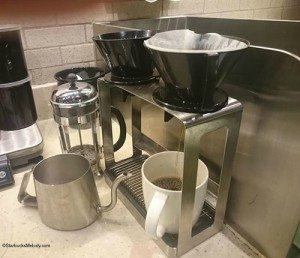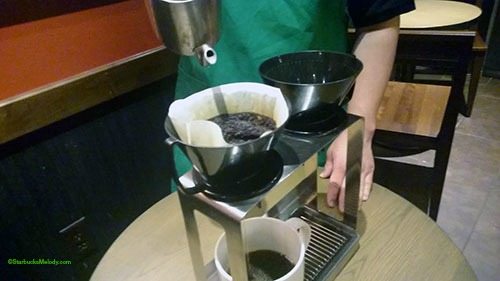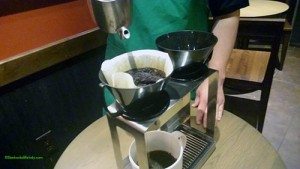Introducing a guest article on the Starbucks pour over: Nick is a four year Starbucks partner in Mississippi. He’s also the author of his own blog about coffee and Starbucks: CoffeeSlang.com. Here’s his article:
 On December 5th, 2014, Starbucks ventured out and opened its first ‘third wave’ coffee shop called the Starbucks Reserve Roastery and Tasting Room in none other than Seattle, Washington. As a barista, I have to say this made me quite giddy. For me, as a barista who is truly passionate about coffee, it meant that Starbucks hasn’t totally forgotten its roots by making Frappuccinos and pastries its first priority while pushing coffee to the wayside. As we are all aware that these items are a necessity for the business and are truly important, however coffee is and should always be our firm foundation.
On December 5th, 2014, Starbucks ventured out and opened its first ‘third wave’ coffee shop called the Starbucks Reserve Roastery and Tasting Room in none other than Seattle, Washington. As a barista, I have to say this made me quite giddy. For me, as a barista who is truly passionate about coffee, it meant that Starbucks hasn’t totally forgotten its roots by making Frappuccinos and pastries its first priority while pushing coffee to the wayside. As we are all aware that these items are a necessity for the business and are truly important, however coffee is and should always be our firm foundation.
Upon receiving notice of the opening of Starbucks Reserve Roastery and Tasting Room in Seattle, Starbucks sent out a memo to baristas informing us that we are changing the method in which we brew our pour over and that each store would receive a goose-neck pour over kettle. This was music to my ears! I was experimenting for weeks with pour overs before this news came down the pipeline.
Pour overs, just in case you’ve never heard of it, can be simply defined as pouring hot water manually over coffee grounds that brews a single serving cup of coffee. Sounds simple, right? Yet, over the past couple of years, coffee enthusiasts around the world have been working hard at methods in order to achieve coffee greatness and the perfect extraction.
There are several brewing methods out there for the pour over, but we’ll tackle the brewing method that Starbucks has implemented, and go over some terminology. As a starting point, it’s good to note that, prior to the updated brewing method, the standard was to fill pitcher with hot water, grind the coffee beans to a medium/fine setting in the burr grinder, and simply pour the hot water over the grounds. The process was completed once the cup was filled with coffee.
Now, by adding the goose-neck kettle, the barista has more control over the water flow which leads into the first step of the process. We begin by setting a timer for four minutes and filling the kettle with triple filtered water and lightly wetting the freshly ground coffee which is a process called blooming. Blooming the coffee is a 30-second process that extracts and releases the trapped co2 gasses that are locked inside the coffee, thus allowing the water to fully penetrate the grounds to achieve full extraction. The goose-neck comes in handy because, when used properly, it will keep most of the water inside the grounds and filter for the blooming process. At this point, the coffee will begin to bubble and rise.
After the blooming process, the barista then begins to pour the rest of the water in a circular motion very gradually. A thin stream of coffee will begin to fall into the cup. The barista is very careful to keep a steady stream and never allowing a drip as this will release a more bitter flavor to the coffee. The process is complete after four minutes of extraction.
As an added measure when I make a pour over, I make sure that before I add the grounds, I wash the filter first in order to remove any filter dust. This is actually a common practice and makes for a cleaner cup of coffee. Keep in mind however that this isn’t a standard practice so if you are wanting to try a pour over and would like your filter washed, ask your barista to do so when you order.
As a side by side comparison with the same coffee brewed in a standard brewer, the results are quite dramatic. With a pour over, the overall taste tends to be more clean with a bolder finish, while adding more body to the overall texture. I highly recommend Guatemala-Antigua, which is known for its juicy lemon and subtle chocolate notes, if you’re up for trying a pour over the next time you visit Starbucks.
If you want to be a guest contributor on StarbucksMelody, scroll down and check out the submission guidelines. Thank you Nick for your article. I sent Nick a Roastery card as a thank you!
Related posts
16 Comments
Leave a Reply Cancel reply
You must be logged in to post a comment.
Sponsors
Recent Comments
- DEVIN on Compostable Straws Land in Seattle Starbucks Stores
- coffeebeanz on Why do you go to Starbucks less often? (If that’s true for you)
- Willi on You can now buy a Siren statue: $6,000
- Willi on A major revamp of your drink recipe: Testing syrup extracts and cane sugar
- Skip on Why do you go to Starbucks less often? (If that’s true for you)








Great job Nick. I was that person too who was giddy for the gooseneck kettle. One person thought it was a steamer pitcher to which I was like NO! then proceeded to have a lesson with some partners before I even read the materials. I am a bit of a coffee geek I guess!
I must say that I’m impressed at this partners passion… I’ve come to many Starbucks stores, looking for suggestions on different brewing methods for different coffees, only to hear, “I hate coffee ” or, “I don’t drink coffee”. To me, a connoisseur of coffee, this is a huge turn off, especially when I’m specific about what I want then questioned about it. It’s nice to see a method such as a pour over doted upon like this. Thank you!!!
Well done, Nick!
Launce, I cringe when I hear about these experiences from customers. The sad reality is, is that some baristas just don’t like coffee which is understandable. The problem comes in when they don’t like coffee and they express that they don’t with customers. Baristas should always have a suggestion for a customer, if it is available, or get the attention of a barista who is passionate about coffee to cater to the customer.
Beautiful article! Love it, the only thing I really don’t like is when partners say “We only have Pike available” and when i ask if they do pour overs they do a little *sigh* yes we do. if only partners were as passionate as Nick! Hats off to you Nick, wish all baristas really put their heart into it.
If the company paid their partners to meet all the work and knowledge they are supposed to have I bet there would be more passion for coffee. Unfortunately, for twenty cents over minimum wage you get what you pay for…
Whoa there @Bea, you do not understand the dynamics of business, the employee, and the marketplace. Under no circumstances should an employee give less than 110%. You will never be paid what you think you are worth, but believe me your boss will not only pay you what you are worth, but if you show initiative you will advance in responsibility and pay. Your comment is a prime example of how the minimum wage has created an entitlement mentality.
No matter how much you hate your job there is absolutely no excuse reflecting that in the service you give to the customer or the attitude you reflect to your fellow employees.
@DadCooks – I’ve always heard it said that one should work to the pay level that you want to aspire to in the future, not the >current< pay level. That's ingrained in me but I realize that lots of people feel that they deserve to work less because "they're not paid enough."
What a great post Nick! I’m the only Coffee Master at my store and I am so happy to see that I’m not the only person who cares about pour overs or blooming. Thank you for your passion!
I love making pour overs!!! I’ve added the extra step of pre-wetting my filters, too. It makes it taste a lot better! And my filters are near a hot water spout where I can easily do it!!! Yay for good neck kettles and the people who get giddy over it!! 🙂
Hi Melody,
Thank you for sharing another great article about Starbucks recent brew. I am a big fan of Pour Over brew. I am a barista also. I notice a lots of barista where I work DID NOT FOLLOW the posted instruction brewing method for Pour Over which it said it has to be pre ground before scoop out the measure amount. As for me, I prefer to ground fresh before brew. Therefore, i measure 2 tablespoon whole bean = 6 oz filter water to all brewing method to perfect a cup of
delicious coffee. I just wish Starbucks would give more attention to all Partners training on varieties brewing coffee at home. Thank you
@DADCOOKS— I own four small bussinesses and was at one time a manager for Starbucks, and can assure you I understand the dynamics of business, the employee, and the marketplace. I also understand that a company who doesn’t invest in employee pay (you cannot use free beverages or bistro boxes to pay rent!) will generally get employees who are not invested in the product. I watched hard working, smart people quit because the expectations from the higher-ups was not realistic to an entry-level, minimum wage job. It makes me sad when there isn’t a passion for coffee when I go to Starbucks, but I also know you cannot pay someone what Starbucks does and expect a vast knowledge of coffee—there is nothing in it for the employee. I pay all of my workers well, offer them health insurance, vacation, and DO NOT make anywhere near what Starbucks or Howard makes because I want employees who invest in me and my company!’
@bae – While I understand your position, I will kindly disagree. As a business owner, you would understand that paying for a 4 year degree (which Starbucks is doing), matching stock and 401k (up to 5%), and great health insurance should be included as part of the salary/wages. Howard and Starbucks leads the pact in our industry as far as compensation is concerned, so much so, that every one scratches their heads wondering how we pull it off as a company for each partner.
I have the mind set that passion comes first and everything else will follow and I’m quite passionate about coffee and how customers respond to our products. I’m a proud partner!!
Nick, thank you for sharing your passionate post about pour-overs! I’ve discovered the joy of the pour-over thanks to Starbucks (and now do it at home, too!), and when I first discovered they did this, I felt a little bad asking them to take the extra time for me. The fact is, though, they’ve always been happy to do it for me. That shows me people who are definitely passionate about coffee, even if I get the impression that not every barista totally “gets” why I ask for a pour-over. The point is, they do it — and so my passion for yummy coffee is met with both that yummy coffee and a passionate customer-centered purveyor of that coffee…for which I’m thankful.
I had a customer ask for a pour-over of Pike, which we (of course) had on brew. I asked him why he preferred a pour-over, and his response was “I know I’m being a pain…” at which point I stopped him. I explained that I was a Coffee Master and was genuinely interested in why some people prefer different brewing methods. He smiled and looked so relieved! We ended up having a 10 minute conversation about coffee, brewing methods, Reserve Stores, and he showed me pics from his recent visit to The Roastery. These are the customer interactions that just make my day! 🙂
seriously, Nick, i had no idea of the “why” behind the gooseneck kettle. thanks for sharing. very helpful!